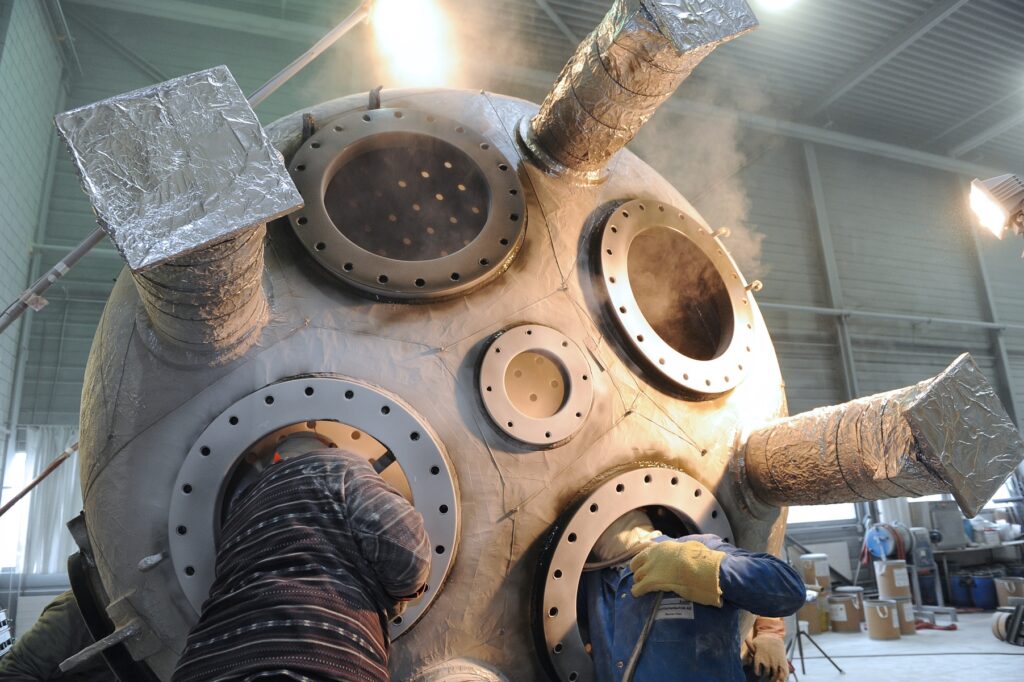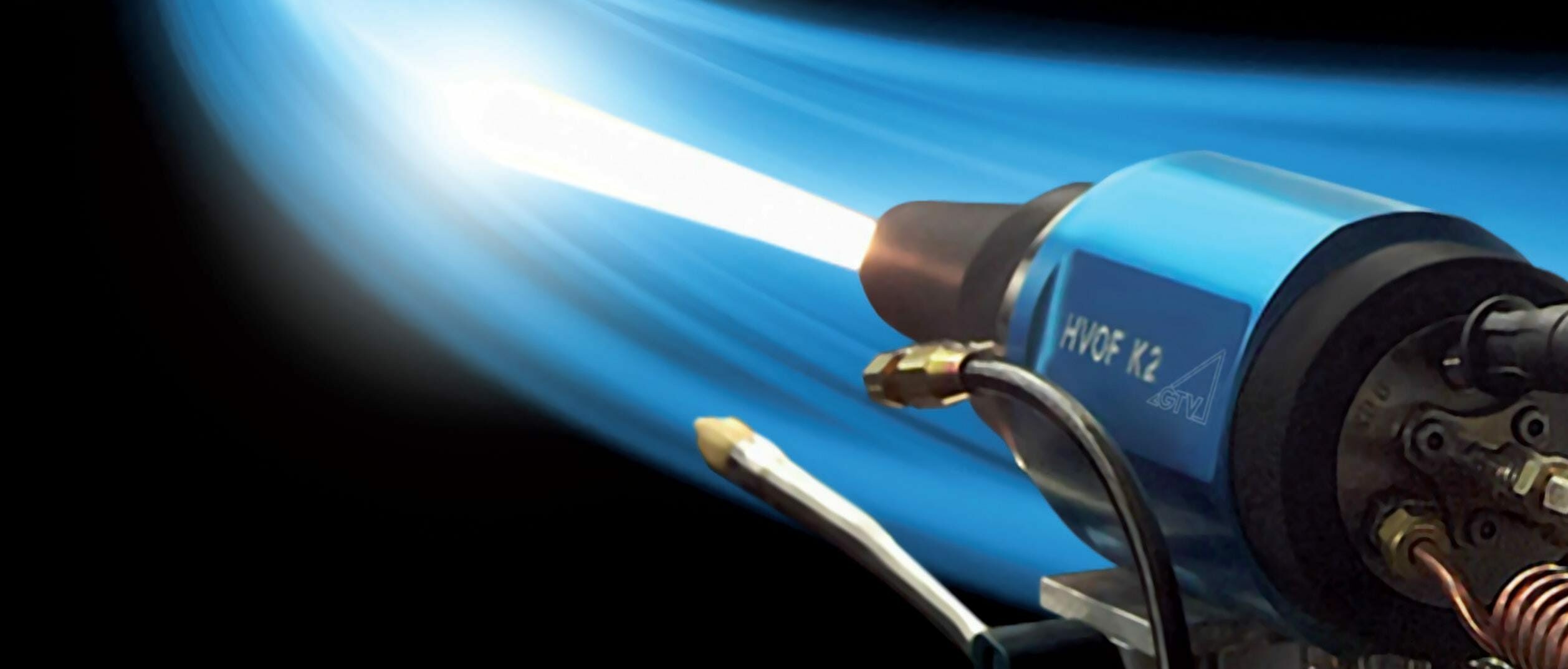Excellent anti-adhesion properties, high temperature resistance combined with chemical resistance and good electric properties.

The synthetic coating is a fluoropolymer powder coating providing the surface with high-quality properties. While it is basically the low friction coefficient in mechanical and vehicle engineering and the good dielectric properties in the electrical industry, this material range has now also found its field of application in the chemical industry. Thanks to the almost universal chemical resistance, the high temperature resistance, the exceptional anti-adhesion properties and the physiological harmlessness, the powder coating is the coating system of first choice.
The synthetic coating process
Upon delivery of your component, we subject it to an extensive incoming good inspection for possible damage such as corrosion and/or pitting corrosion and for coating conformity. If your component requires repair, we will complete these repairs in consultation with the customer. Afterwards, the components will be pre-treated accordingly.
Depending on the coating material and the component, the actual coating process will be completed as wet painting process, electrostatic powder coating, whirl sintering or powder flame spraying. After the coating process, the component is sintered (several times in case of powder coating) to provide for the integration of the coating and the development of its actual properties. If necessary, mechanical rework or more surface finishing processes such as glass bead blasting and electropolishing and, if necessary, assembly works are completed.
At the end of every synthetic coating process, there is a quality check. Layer thickness, pore check with high voltage, cross cut as well as discharge capability are measured and recorded. Upon request, the customer is provided with all measurement and test records as well as the corresponding approvals.
Environmentally friendly, sustainable synthetic coating
The synthetic coating is one of the most environmentally friendly coating processes. Worn or defective coatings can be removed and renewed. You don’t have to replace the entire component. We mainly obtain the energy for our processes from the solar system of Buser Group which is installed on our production building.
Coating conformity of your components
To ensure the coating conformity of your components, coating of the components must already be considered in the construction phase. Depending on the system, a fluoropolymer synthetic coating has a layer thickness between 20 µm and 1000 µm.
Components with synthetic coating offer many advantages
Most different coating processes are used, depending on the requirements:
- E-CTFE has very good electric insulation properties. At room temperature, the mechanical properties are comparable to those of nylon 6. ECTFE has very good values for impact resistance at low temperatures and room temperature: the application ranges from cryogenic temperatures to 150°C. ECTFE shows good chemical resistance and little permeation. The resistance to weather conditions of any kind and radioactive radiation is excellent. ECTFE is one of the best fluoropolymers with regard to abrasion resistance.
- Due to its good resistance to many aggressive chemicals (e.g. acids, aromatic hydrocarbons), ETFE serves as coating material for chemical equipment and containers and as material for valves, fittings and hoses. Compared to PTFE, the temperature stability is lower (max. 155°C) Another application is the protection of thin-layer solar cells by means of lamination with ETFE foil.
- FEP distinguishes itself by excellent anti-adhesion and low-frication properties in combination with improved abrasion resistance as compared to PTFE. In use, however, FEP coatings only withstand temperatures of up to 205°C. One important function is the water-repellent (hydrophobic) character of this plastic. Can be sterilised with gamma, ETO, E-Beam and autoclave.
- Sol-gel layers In addition to the hydrophobic fitting of surfaces, hydrophilic surfaces with “anti-fog” properties as well as hydrophobic and hydrophilic properties can be achieved by modification of the starting compounds; have a self-cleaning and anti-adhesion effective, anti-fingerprint.
- PFA is resistant to almost all chemicals (except for alkali metal melts), shows very high temperature resistance (application temperature up to 260°C) and is flame-retardant. PFA has a low friction value, a largely inert behaviour, high sliding abrasion and extremely low adhesion. It offers the best corrosion protection and distinguishes itself by very high resistance to diffusion, even at higher temperatures.
- PA, PE and EP are materials with medium quality for use as isolators and specific applications.
- PUR Due to the excellent mechanical properties, certain polyurethanes are suitable for applications requiring high wear resistance. E.g. when transporting bulk goods through polyurethane hoses or as protective layer on grippers, bending rollers and in pipes and pipe bends. With most polyurethanes, the application temperature ranges from -30 to +80°C. Short-time effects of higher temperatures up to 135°C are admissible, in the long run, this will, however, lead to the reduction of elasticity.
- PEEK shows excellent stability, rigidity, good creeping properties and fatigue resistance. High abrasion and notch resistance in combination with a low friction coefficient. Good hydrolysis resistance up to about 280°C, little humidity absorption; resistance in steam atmosphere and in fresh and salt water with little permeability. PEEK offers an effective barrier to the permeation of liquids and gases. The solubility of liquids and gases in PEEK and their diffusion through PEEK are considerably less than with other plastics.
- PEKK Parts coated with PEKK generally have properties similar to those with PEEK coating; however, with better “high temperature performance”. PEEK shows excellent wear resistance – up to three times better than PEEK. The temperature load is 60°C lower than with PEEK and the considerably lower shrinkage stress enables the coating of geometries that would per se be unsuitable. Also when it comes to the pressure resistance, PEKK is often better. The humidity absorption of PEKK is considerably lower than that of PEEK; depending on the type, it is up to 6 times less.
- PVDF Due to its good thermal and chemical resistance, PVDF is used as classing for pipes or external components. It is moreover used for seals, membranes and packaging foils. Apart from that, it is also used in the measurement technology, e.g. for coating measuring probes.
- PTFE is temperature-resistant from -270°C to 260°C (with little mechanical load and excellent anti-adhesion properties, universal chemical resistance and a low friction coefficient, thus good low-friction properties.
- Thanks to the very low surface energy, silicones are a favourably anti-adhesion coating. Silicones are e.g. used for sealing thermally sprayed layers.
